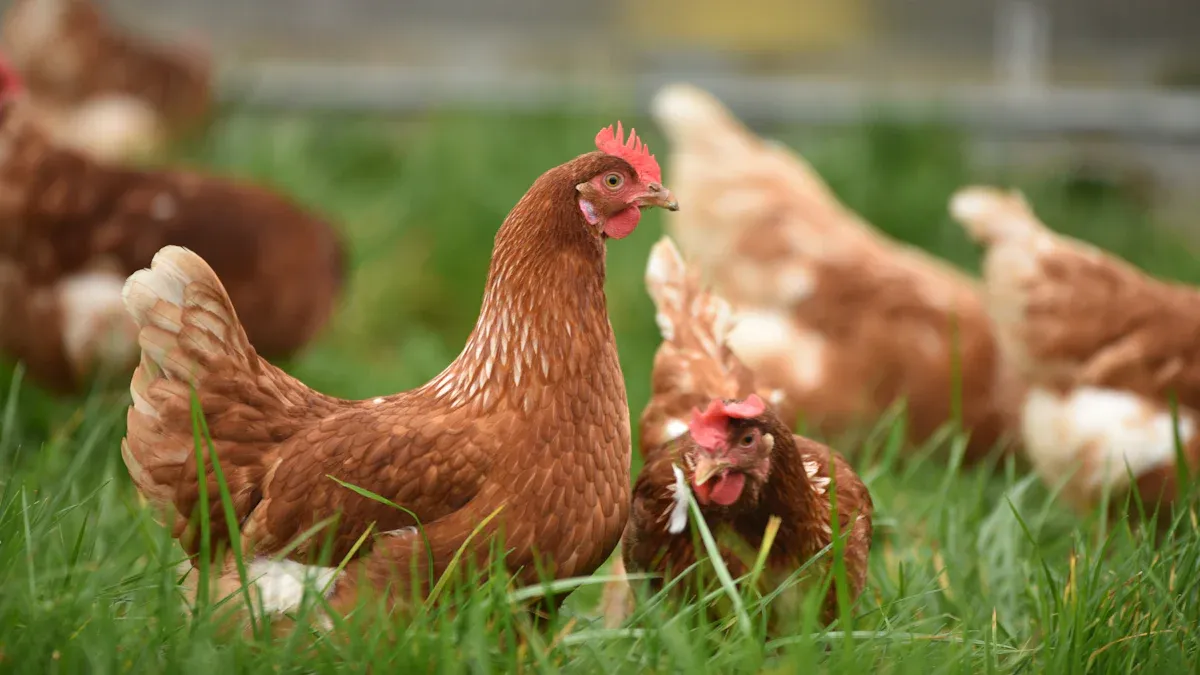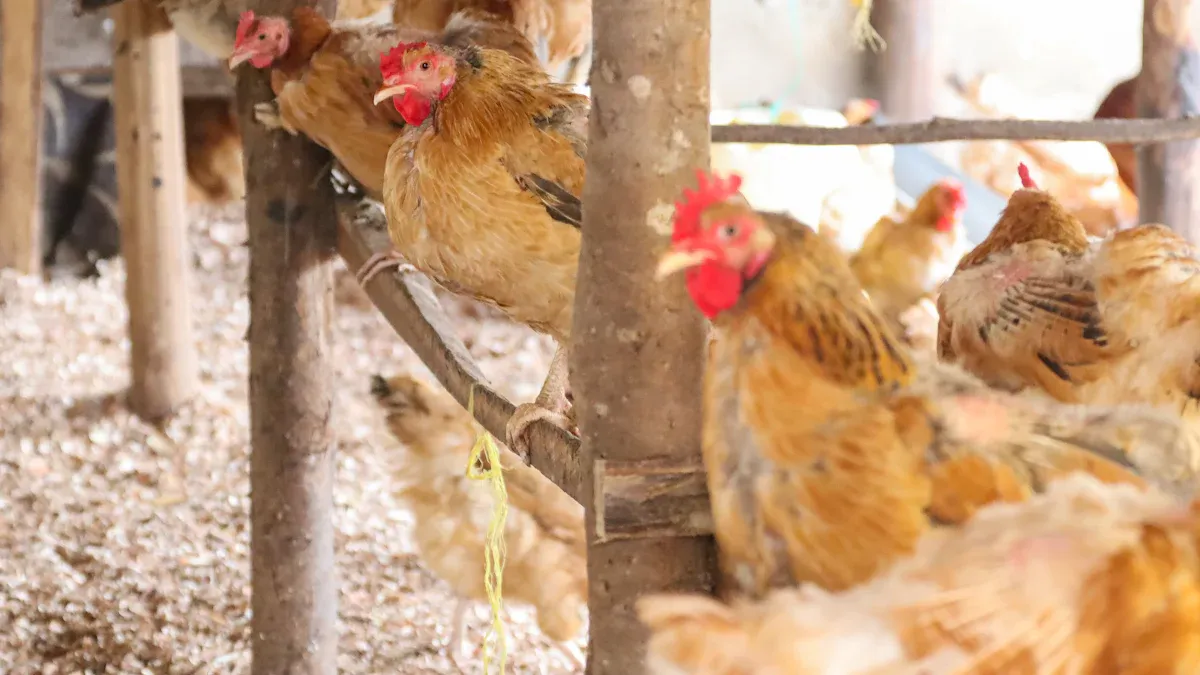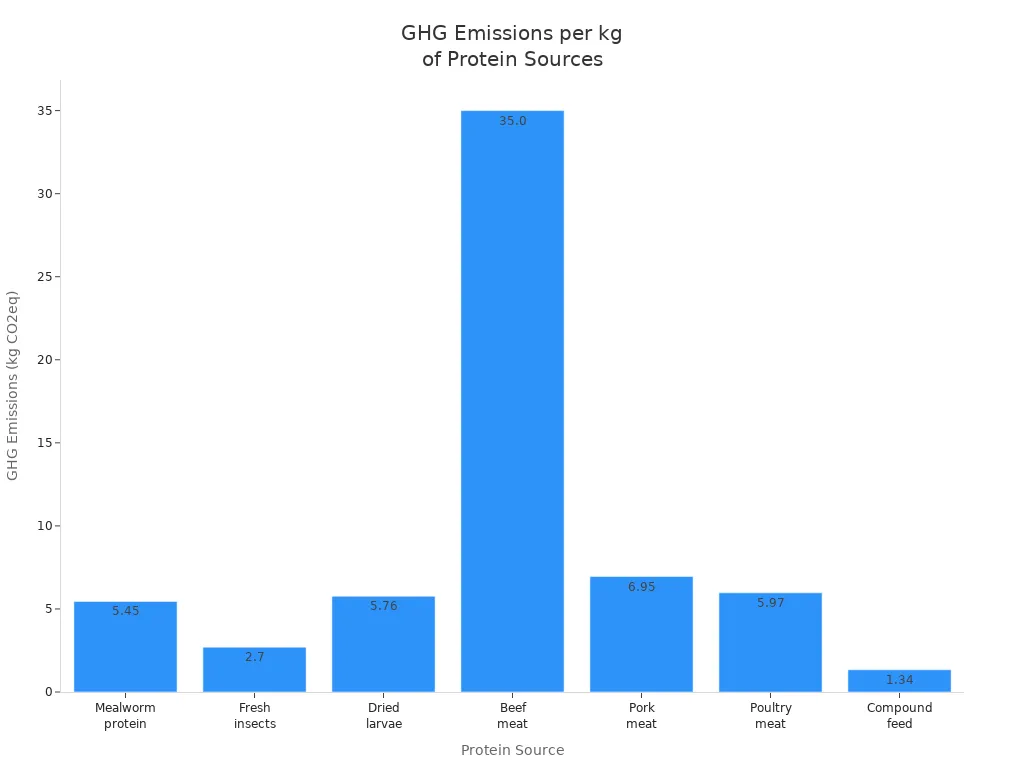
Mealworms in Poultry Diets offer a rich protein source, supporting bird health and growth. Studies show that mealworm farming produces fewer greenhouse gases than traditional livestock. In South Africa, 72% of small-scale farmers express willingness to adopt mealworms, reflecting a shift toward sustainable, efficient protein sources in modern agriculture.
Key Takeaways
- Mealworms provide high-quality protein, essential fats, and important nutrients that support poultry growth, health, and egg quality.
- Using mealworms in poultry diets reduces environmental impact by saving water, land, and lowering greenhouse gas emissions compared to traditional protein sources.
- Feeding mealworms as a supplement two to three times a week helps improve bird health, encourages natural behaviors, and boosts farm sustainability.
Mealworms in Poultry Diets: Nutritional Value

Protein and Amino Acid Content
Mealworms in Poultry Diets provide a rich source of protein, which is essential for poultry growth and health. The protein content in mealworms can range from 36.3% to 74.1% on a dry matter basis, depending on their diet. This makes mealworms a strong competitor with traditional protein sources like soybean meal and fishmeal. The table below compares the protein content of common feed ingredients:
| Protein Source | Crude Protein Content (DM basis) | Additional Notes |
|---|---|---|
| Soybean Meal | 45% | Common plant-based protein source |
| Fishmeal | 66% | High protein animal-based source |
| Mealworms (T. molitor) | Protein-rich, 36.3–74.1% | Contains chitin and fat; suitable for partial replacement (<5%) |
Mealworms contain all essential amino acids except tryptophan and methionine. They offer histidine, isoleucine, leucine, lysine, phenylalanine, threonine, valine, and arginine. The amino acid profile of mealworms is similar to or even better than that of fishmeal and soybean meal. Poultry can digest these amino acids efficiently, with digestibility rates between 85% and 95%. This high digestibility supports strong muscle development and healthy growth in birds.
Tip: Including mealworms in poultry diets can help balance amino acid intake, especially when combined with other protein sources.
Essential Fats and Micronutrients
Mealworms supply essential fats that are important for poultry health. Their fat content includes saturated fatty acids (about 28.61%), monounsaturated fatty acids (52.89%), and polyunsaturated fatty acids (18.49%). Key fatty acids found in mealworms are linoleic acid (omega-6) and α-linolenic acid (omega-3). These nutrients support normal body functions and help maintain healthy skin and feathers.
Farmers can improve the fatty acid profile of mealworms by feeding them seed meals like flax, chia, or hemp. This practice increases the omega-3 content and creates a healthier balance between omega-6 and omega-3 fatty acids. A better fatty acid ratio benefits poultry by supporting heart health and reducing inflammation.
Mealworms also provide important micronutrients. They are rich in vitamin B12, calcium, zinc, and iron. These nutrients help improve growth, support strong bones, and boost the immune system. Studies show that including mealworms in poultry diets can increase serum protein and thyroid hormone levels, which are signs of good health. However, experts recommend keeping mealworm meal at or below 6% of the total diet to avoid negative effects on meat quality.
Impact on Egg Quality and Growth
Mealworms in Poultry Diets can influence both egg quality and growth rates in birds. Research on quails shows that adding mealworms to their feed improves the oxidative stability of eggs. This means the eggs stay fresh longer and have better nutritional value. The eggs also have a milder taste, with less sulfur and oily flavors. Although direct studies on laying hens are limited, these findings suggest potential benefits for egg production and quality.
For broiler chickens, adding low levels of mealworm meal (2.5% to 5%) during the starter period leads to higher body weight gain and better feed conversion ratios. Birds grow faster and use their feed more efficiently. These improvements do not come with increased feed intake or higher mortality rates. The presence of chitin in mealworms may also play a prebiotic role, supporting gut health and nutrient absorption.
- Improved growth rates and feed efficiency
- Better egg freshness and taste in quails
- No negative effects on bird health at recommended inclusion levels
Note: Mealworms in Poultry Diets offer a natural way to boost both productivity and product quality on modern farms.
Practical Use of Mealworms in Poultry Diets

Recommended Feeding Amounts and Frequency
Farmers often use mealworms as a protein supplement for chickens and other birds. Experts suggest feeding less than 10 mealworms per bird each day. This amount increases protein intake without upsetting the balance of nutrients. Mealworms are not a complete diet. Poultry need a mix of grains, seeds, and other protein sources for best health. Most farms add mealworms as a treat or supplement, not as the main feed. Feeding mealworms two to three times a week supports growth and natural foraging behaviors.
Tip: Start with small amounts and watch how the birds respond. Adjust the frequency based on their needs and age.
Methods of Incorporation: Fresh, Dried, and Processed
Mealworms come in several forms for poultry diets. Farmers can choose fresh, dried, or processed mealworms. Each form has different nutritional values and storage needs.
| Mealworm Form | Moisture Content | Crude Protein (CP) | Crude Fat | Ash Content | Calcium Content |
|---|---|---|---|---|---|
| Fresh | ~60-72% | N/A | N/A | N/A | Low |
| Dried | Low | 46%-52% | 25%-35% | Low | Low (0.04%) |
Fresh mealworms have high moisture, making them prone to spoilage. Drying removes water, concentrates protein and fat, and makes storage safer. Freeze-dried mealworms keep protein quality but may have higher fat oxidation. Microwave and vacuum drying methods also work well and keep nutrients stable.
Balancing Mealworms with Other Feed Ingredients
Mealworms in Poultry Diets work best when balanced with other protein sources. Research shows that replacing 5-10% of soybean meal with mealworms supports growth and gut health in broilers. Farmers should blend mealworms with grains and other proteins to meet all amino acid needs. Supplementing with extra methionine, lysine, or threonine may be necessary. The right balance depends on bird type, age, and health goals. Many premium and organic feeds now use mealworms as a sustainable protein option.
Mealworms in Poultry Diets: Health and Welfare Benefits
Supporting Immune Function and Digestion
Mealworms in Poultry Diets help birds stay healthy by supporting their immune system and digestion. Scientists found that feeding yellow mealworm and super mealworm to chickens changes the gut microbiota. This reduces harmful bacteria like E. coli and Salmonella. Chitin, a natural compound in mealworm shells, boosts the immune response and increases antibody levels. Studies by Bovera and others showed that broilers eating mealworms had stronger immune systems and better disease resistance. Researchers also noticed that low levels of mealworm meal improve gut health and digestion. Birds gain more weight and eat more feed, but high amounts may affect the intestines. Keeping mealworm levels low gives the best results for gut health.
Promoting Natural Foraging Behaviors
Mealworms encourage chickens to act naturally. When farmers scatter mealworms on the ground, chickens start pecking, scratching, and chasing. These actions mimic wild foraging and keep birds active. Studies show that chickens spend more time exploring and less time being bored or stressed. This activity can fill up to 60% of their day. Mealworms are more attractive than other treats, so they motivate birds to move and interact. Increased foraging also helps reduce negative behaviors like feather pecking.
Tip: Scattering mealworms once or twice a week can make chickens happier and healthier.
Feather Development and Recovery
Feather growth and recovery improve with mealworm feeding. Mealworms provide high-quality protein and important amino acids like lysine and methionine. These nutrients help birds regrow feathers quickly, especially during molting. Flocks that eat mealworms have shinier, healthier feathers and show less feather pecking. Farmers often notice plumper birds and faster feather recovery. Mealworms also support gut health and immunity, which further aids feather development.
Sustainability and Environmental Impact
Resource Efficiency Compared to Traditional Feeds
Mealworm farming uses fewer resources than traditional protein sources like beef, chicken, and fishmeal. Studies show that mealworms have a nutrient and amino acid profile similar to soybean and fishmeal. Poultry fed with mealworms grow well and digest their food efficiently. Mealworm production needs less water and land than livestock or feed crops. The water footprint for mealworms is about 4,341 m³ per ton, which matches chicken and is much lower than beef. Mealworms also use land more efficiently, needing up to 70% less land than traditional livestock. Their feed conversion ratio is better, which means they turn feed into protein with less waste.
| Metric | Mealworm Farming | Traditional Livestock (Beef/Chicken) |
|---|---|---|
| Water Footprint (m³/ton) | ~4341 | Beef: ~15100; Chicken: ~4341 |
| Land Use (m²/kg protein) | 4.1 to 22.38 | 70% more land than mealworms |
| Greenhouse Gas Emissions (kg CO2-eq/kg protein) | 20.4 | 18-72% higher than mealworms |
| Feed Conversion Ratio (FCR) | 3.8 to 5.8 | Higher (less efficient than mealworms) |
| Energy Use (MJ/kg) | 141.3 | Higher energy consumption |
Reducing Environmental Footprint
Mealworm production creates fewer greenhouse gases than beef and pork. It also matches or beats chicken and fish in some cases. The emissions per kilogram of mealworm protein range from 3.9 to 7 kg CO2-eq, while beef produces up to 35 kg CO2-eq per kilogram. Using mealworms in poultry feed can cut greenhouse gas emissions by up to 77% if production is efficient. The chart below shows how mealworms compare to other protein sources.

Role in Circular Farming Systems
Mealworms help create circular farming systems. Farmers can feed mealworms with food waste or by-products like wheat bran. Mealworms turn these low-value materials into high-quality protein for poultry. Their frass, or waste, acts as a natural fertilizer that improves soil health. Vertical farming systems for mealworms save space and recycle water. These practices reduce food waste, recycle nutrients, and lower the environmental impact of poultry farming. Mealworms support a sustainable future by closing the loop in agricultural production.
Economic Considerations of Mealworms in Poultry Diets
Cost Comparison with Conventional Protein Sources
Mealworms offer many nutritional and environmental benefits, but their economic impact remains a key consideration for farmers. Socio-economic studies show that using yellow mealworm as a substitute for fishmeal in poultry diets currently results in higher costs. These costs come from investment in production facilities, labor, and consumables. At present, the overall financial balance is negative when including these factors. However, experts believe that scaling up production and improving technology could lower costs in the future. For example, a large increase in production scale and reduced labor needs may make mealworm farming more profitable. Circular economy models, where mealworms are raised on food waste, can also improve sustainability and reduce expenses. Avoided environmental costs, such as less fishing for fishmeal, may add further value, but these benefits need more study to measure in dollars. Farmers should consider both the current costs and the potential for future savings as the industry grows.
Market Availability and Trends
The global market for mealworms continues to expand, especially in animal feed. In 2024, animal feed holds the largest share of mealworm use, driven by demand from poultry, aquaculture, and pet food industries. Whole mealworms remain popular because they provide natural protein, have a long shelf life, and are cost-effective. The table below highlights key market trends:
| Aspect | Details |
|---|---|
| Application Dominance | Animal feed leads with 44.1% share in 2024 |
| Nutritional Benefits | High protein, essential amino acids, vitamins, healthy fats |
| Sustainability Drivers | Environmental concerns push adoption |
| Regional Regulatory Support | Favorable rules in Europe and North America |
| Product Preference | Whole mealworms preferred for protein and shelf stability |
Technological advances, such as automated breeding and vertical farming, help lower production costs and improve efficiency. Companies invest in research and expand through partnerships. While regulations differ by region, government support and consumer awareness drive robust market growth. Mealworms are becoming more available as these trends continue.
Note: As the market grows and technology improves, mealworms may become a more affordable and accessible protein source for poultry farmers.
Potential Challenges and Solutions
Nutritional Imbalances and Overfeeding Risks
Mealworms provide valuable nutrients, but farmers must use them carefully. Overfeeding mealworms can cause problems for poultry.
- Chickens may eat too much fat and protein if they get too many mealworms.
- Dried mealworms can contain up to 40% fat, while live ones have about 15%.
- Too much fat can lead to weight gain and lower egg quality in hens.
- Poultry need a balanced diet with grains, greens, and protein.
- Feeding mealworms as a treat, not as the main feed, helps keep this balance.
- Healthy fats in mealworms, like oleic and linoleic acids, support energy and feather health, but moderation is key.
Farmers should always combine mealworms with other feed ingredients. This approach ensures chickens get all the nutrients they need for growth and egg production.
Digestibility and Calcium Deficiency
Mealworm meal improves how chickens digest protein and amino acids. Studies show that adding mealworm meal to broiler diets boosts weight gain and feed efficiency.
- Mealworms help chickens absorb nutrients better and support healthy gut bacteria.
- Chitin in mealworms acts as a prebiotic, which strengthens the immune system.
No research shows that mealworms cause calcium deficiency in poultry. Farmers should still provide a complete diet with enough calcium, especially for laying hens.
Sourcing and Quality Control
Quality control matters when choosing mealworms for poultry feed.
- Farmers should monitor the health and welfare of the insects.
- The feedstock used to raise mealworms must be high quality.
- Regular testing helps detect contaminants and pathogens.
Choosing trusted suppliers ensures that mealworms remain a safe and nutritious addition to poultry diets. Products from reputable brands offer consistent quality and support healthy flocks.
Mealworms in Poultry Diets offer high protein, essential fats, and vital nutrients that support bird growth and health. Their use reduces environmental impact and fits modern, eco-friendly farming. As technology advances and demand grows, mealworms will play a bigger role in sustainable poultry nutrition worldwide.
FAQ
Are mealworms safe for all types of poultry?
Yes. Chickens, ducks, turkeys, and quail can safely eat mealworms. Farmers should always use high-quality mealworms from trusted suppliers.
How often should poultry eat mealworms?
Farmers usually feed mealworms two to three times a week. This schedule supports healthy growth and natural foraging behaviors.
Do mealworms improve egg quality?
Studies show that mealworms can help produce eggs with richer yolk color and better taste. They also support stronger eggshells.


